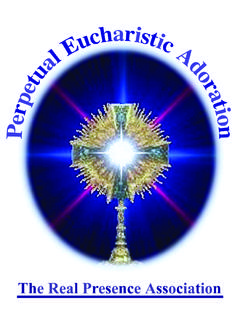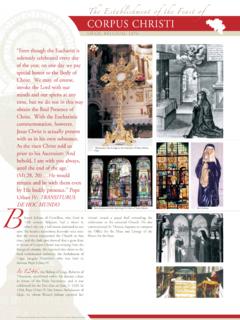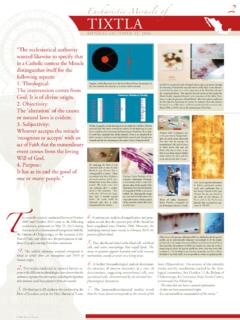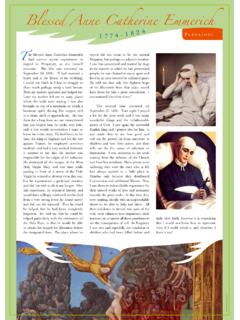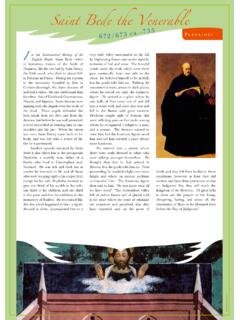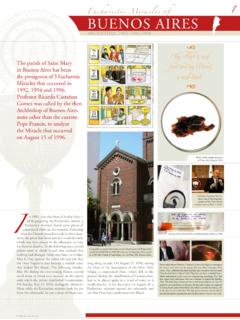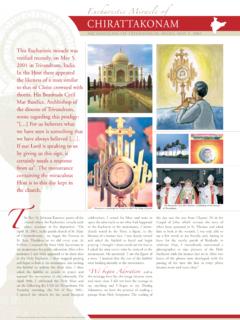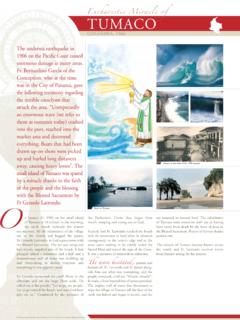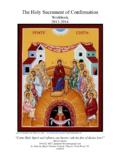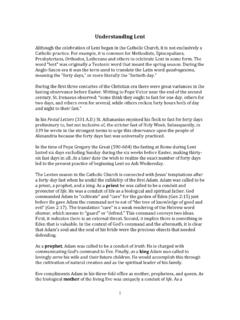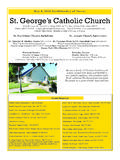Transcription of Book: The Catholic Understanding of the Bible
1 1997 Inter M irifica No rep roductions shall be mad e without p rior written p ermission 1 THE Catholic Understanding OF THE Bible john A. Hardon, 1997 Inter M irifica No rep roductions shall be mad e without p rior written p ermission 2 THE TABLE OF CO NTENTS INTRODUCTION Historic Christianity PART ONE THE BI BLE CHAPTER I THE BI BLE AS THE WORD OF GOD Revelat ion Natural Revelat ion Supernatural Revelat ion Sacred Tradition Sacred Scripture CHAPTER II INSPIRATION IN THE Bible Testimony of the Scriptures Church s Teaching How Is the Bib le Inspired? Implicat ions Inerrancy No Contradictions Or ig ina l T ext Reverence for the Word of God CHAPTER III THE CANON OF THE BI BLE The Old and New Testaments Old Testaments Palestinian and Alexandr ian Canon New Testament CHAPTER IV HOW THE OLD AND NEW TESTAMENTS ARE RELATED Fulfillment Perfection Continuat ion Interpretation Complet ion 1997 Inter M irifica No rep roductions shall be mad e without p rior written p ermission 3 Developm ent Developm ent of Doctrine Developm ent of Revelat ion
2 Incarnation CHAPTER V THE INTERPRETATION OF THE Bible Science of Hermeneutics Basic Meanings The Literal Sense The Mystical Sense Teaching of Second Vat ican The Meaning of the Human Writers The Intention of the Holy Spir it PART TWO THE BOO KS OF THE BI BLE CHAPTER VI THE OLD TESTAMENT St. Matthew St. Mark St. Luke St. john s Gospel CHAPTER VII THE NEW TESTAMENT The Gospels St. Matthew St. Mark St. Luke St.
3 john Acts of the Apostles Letters of St. Paul T he Catholic Ep is tles James Peter john Jude The Apocalypse PART THR EE M ASTER THEM ES OF THE BI BLE 1997 Inter M irifica No rep roductions shall be mad e without p rior written p ermission 4 CHAPTER VIII OUR KNOWLEDGE OF GOD Natural Knowledge Revealed Knowledge CHAPTER IX OUR LOVE OF GOD Old Testament New Testament CHAP T E R X MES S I ANI S M Concept of the Messiah Messianic Development Patriarchal Period Royal Messianism The
4 Exile and After Three-Fold Annoint ing PART FOUR SPIRITUAL TEACHING OF THE GOSPELS CHAPTER XI CHRISTIANITY IS HISTORICAL The Gospels Are Factual The Gospels Are Not Imaginary CHAPTER XII THE WORD OF GOD The Word In Himself The Mission of the Word CHAPTER XIII THE ANNUNCIATION AND INCARNATION CHAPTER XIV THE VISITATION Med iatrix of Grace Ha i l Mar y Full of Grace The Lord Is With Thee Blessed Art Thou Among Women And Blessed Is the Fruit of Thy Womb, Jesus Ho ly Mar y Mother of God 1997 Inter M irifica No rep roductions shall be mad e without p rior written p ermission 5 Pray For Us Sinners Now and At the Hour of Our Death CHAPTER XV MARY MAGNIFIES THE LORD CHAPTER XVI THE LESSONS OF BET HLEHEM Political Power and Jesus Christ The Poverty of the Incarnate God The First Message of the Angel to the Shepherds The Angelic Promise of Peace The Shepherds Came and Believed The Shepherds As First Apostles The Heart of Mary Prayer CHAPTER XVII PRESENTATION AND PURIFICATION Purification of the Blessed Virgin Mary Presentation of Jesus The Nunc Dimittis The Prophetess Anna CHAPTER XVIII THE VISITATION OF THE MAGI The Magi
5 Symbolize the Gentiles Herod Symbolizes the State CHAPTER XIX JESUS FOUND IN THE TEMPLE God Tries Those He Loves Mary s Lesson to All of Us CHAPTER XX BAPTISM OF JESUS john the Baptist Announces Jesus Christ s Baptism and Hum ility Announcement of Christ s Divinity CHAPTER XXI TEMPTATION OF CHRIST BY THE DEVIL Why was Christ Tempted? Temptations of Christ First Temptation Second Temptation 1997 Inter M irifica No rep roductions shall be mad e without p rior written p ermission 6 Third Temptation I N TR O D UC TI O N It must seem strange to write a book on The Catholic Understanding of the Bible . But, it will not be strange once we realize two things: that every major religion in the world has what it calls its Bible , and that among Christians, the Bible is variously understood.
6 Not to speak of the Catholic Understanding of the Bible would be confusing, to say the least, and even misleading. The Bible is not just the Bible . It is the foundation for Christianity. Everything depends on three things: what books form the contents of the Bible , how the Bible is translated, and most importantly, how the Bib le is inter pr eted. All the religions have their own scriptures. The Hindus have the Vedas, Buddhists the Tipitaka, Taoists their Tao Teh Ching, and Moslems the Koran. Just what constitutes a sacred writing and how the scriptures are to be understood are so varied and divergent as to defy scientif ic analysis. Much of the difficulty that a Christian faces in studying other systems of faith arises from this basic difference--betw een the Bib le of Christian ity (and Judaism) and the equivalent sacred literature of other living religions.
7 A standard definition of the Bible is to call it a publication that is preeminent especially in authoritat iveness. Before we go any further, it will be useful to make an overview of how the modern world, more specifically our twentieth and twenty-first centuries, look at the Bible . Without this perspective, we could be using the same words that are currently en vogue when speaking and writing about the Bible , but our contemporaries would not know what we are talking about. Not only has a new biblical vocabulary come into existence, but a totally new perspective of the scriptures has been born. 1997 Inter M irifica No rep roductions shall be mad e without p rior written p ermission 7 HISTORIC CHRISTIANI TY From the dawn of the Christian religion, the followers of Christ have considered the Bible a special communication of God, in which the prophets of the Old Testament and Jesus of Nazareth in the New , revealed to the chosen people the secrets of divine wisdom and the means of salvation for mankind.
8 The Christian Scriptures are not just an important piece of religious writing; nor, as in Islam, only basic guidelines of moral conduct. They are believed to have been co-authored by God, who gave the inspiration and direction to the hagiographer whose faculties of mind, will, and execution were mystically directed by the Holy Spirit, yet without prejudice to the native qualit ies of the human agent. One result of this uniqueness has been the concern of the Church to trace the data and text of the Bible to its earliest possible sources. That is why biblical archaeology and papyrology are distinctively Christian sciences. Since the events described in the Bible and the narratives it contains pertain to certain periods of history, it is imperative to know their historical context. We must therefore know the language and geography, culture and biography, and even economics and biology.
9 Why? Because this knowledge is an invaluable means to better understand the sacred text and come closer to its original and authent ic wording. Nor is that all. Christians assume that to have the biblical text is one thing, even when its authenticity is assured. However, to know the true meaning of the Bible is something else. In every age since apostolic times, Christians have wrestled over the interpretation of the Bible , and wars have been fought over the differences. The science of biblical hermeneutics is also very Christian. Hermeneut ics is the interpretation of Sacred Scripture and inquiring into its true meaning. It defines the laws that biblical scholars are to follow in order to determine and explain the sense of the revealed word of God. So distinctive is hermeneutics that Oriental specialists in the Hindu tradit ion, for example, are baffled by w hat to them seems such w asted effort: w hether Jesus w ords, I and the Father are one, should be taken literally or symbolically.
10 Hinduism allows for avatars, or incarnations of the deity; and advaita, or the identity of God and the universe. It makes no claim to possess objective religious truths and even the search is considered illusory. Thus even the great Mahatma Gandhi never became a Christian because, as he said, the human mind can never know the truth. Life is the constant search for the truth. 1997 Inter M irifica No rep roductions shall be mad e without p rior written p ermission 8 This volume is intended as a textbook for a course on the Catholic Understanding of the Bib le. Its purpose therefore is clearly academic. It w ill deal w ith the basics of biblical study. As we go along, references will be made to authors and sources for a more scientif ic and advanced grasp of Sacred Scripture. It is assumed that those who use this book will do so with a copy of the Bible always at their disposal.
